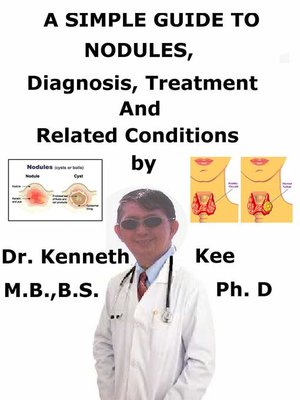
Sign up to save your library
With an OverDrive account, you can save your favorite libraries for at-a-glance information about availability. Find out more about OverDrive accounts.
Find this title in Libby, the library reading app by OverDrive.



Search for a digital library with this title
Title found at these libraries:
| Library Name | Distance |
|---|---|
| Loading... |
This book describes Nodules, Diagnosis and Treatment and Related Diseases
A nodule is a small bunch of tissue which forms in or on the body, normally in reaction to injuries.
Nodules are normally hard and they can be easily palpated.
For the most part, the nodules are benign, but occasionally they can disrupt the function of the body or they may be malignant.
A nodule is a growth of abnormal tissue that can form just beneath the skin.
They can also form in deeper skin tissues or internal organs.
In medicine, nodules are small firm lumps, normally bigger than 1 cm in diameter.
If filled with fluid they are termed as cysts.
Small sized (less than 0.5 cm) raised soft tissue lumps may be termed papules.
The term "nodule" comes from a Latin word suggesting "knot."
These normally benign groups of tissue often do feel like knots
In some cases, they can drag the adjacent tissue in the region to make it feel tight or sore.
Most skin doctors use nodules as a general term to depict any lump underneath the skin that is at least 1 centimeter in size.
It is not a specific diagnosis.
Rather, it is used to inform other dermatologists what they see.
Organs, glands, and other parts of the body can also form nodules, as in the case of thyroid nodules.
Nodules are often used to indicate enlarged lymph nodes (lymphadenopathy).
Areas where lymphadenopathy may form (and thus nodules may be seen) are the:
1. Armpits
2. Groin
3. Head and neck region
4. Lungs
In many cases, nodules on the inside of the body are found incidentally in the course of examining a patient for other disorders, as a nodule inside the body needs some time to become palpable.
Tendons and muscles are both likely to forming nodules in reaction to injury, with masses appearing in areas like the vocal cords fairly often.
These nodules can also happen on the skin or in the layers of the skin, in which case they are normally very noticeable when they are visible.
Upon examination, a nodule is often lighter than the surrounding tissue.
When felt, the nodule may appear hard or rubbery, and it is normally roughly spherical in shape.
Often, multiple nodules form together in a group like a bunch of grapes, and they can vary in size but they generally remain quite small.
The area around the nodule may be red and inflamed, or it may appear normal, depending on the reason it formed, how large it is, and where it is.
If a doctor suspects that a nodule may become a problem, he or she may advise that the nodule be removed.
They can disrupt the function of part of the body, which is a good rationale for removal, and people may also have nodules removed for cosmetic reasons.
Removal may also be done for the purpose of examining the mass to determine if it is malignant.
The evaluation of a skin nodule involves a description of its appearance, its location, how it feels to touch and any linked symptoms which may give signs to an underlying medical disorder.
Nodules in skin are dermatofibroma and pyogenic granuloma.
Nodules may form on tendons and muscles in response to injury, and are often found on vocal cords.
They may happen in organs such as the lung, or thyroid, or appear as a sign in other medical disorders such as rheumatoid arthritis.
A surgical resection is one method to remove a nodule and find out its cause.
If the nodule is non-cancerous, such as a benign thyroid nodule, the doctor may wait and watch the nodule without providing treatment.
Excess thyroid hormones can be treated with medicines.
If a nodule is...







